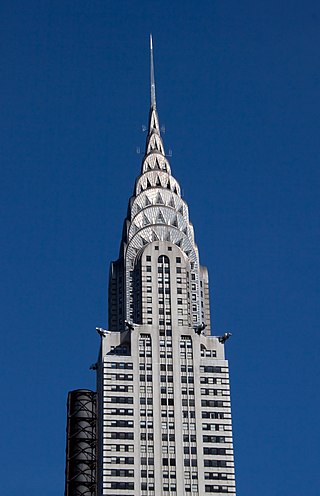
Art Deco, short for the French Arts décoratifs, is a style of visual arts, architecture, and product design, that first appeared in Paris in the 1910s, and flourished in the United States and Europe during the 1920s to early 1930s. Through styling and design of the exterior and interior of anything from large structures to small objects, including how people look, Art Deco has influenced bridges, buildings, ships, ocean liners, trains, cars, trucks, buses, furniture, and everyday objects including radios and vacuum cleaners.

Eritrea is an ancient name, associated in the past with its Greek form Erythraia, Ἐρυθραία, and its derived Latin form Erythræa. This name relates to that of the Red Sea, then called the Erythræan Sea, from the Greek for "red", ἐρυθρός, erythros. But earlier Eritrea was called Mdre Bahri. The Italians created the colony of Eritrea in the 19th century around Asmara and named it with its current name. After World War II, Eritrea annexed to Ethiopia. Following the communist Ethiopian government's defeat in 1991 by the coalition created by various armed groups notably the EPLF and the TPLF among others, Eritrea declared its independence. Eritrea officially celebrated its 1st anniversary of independence on May 24,1993.

Asmara, or Asmera, is the capital and most populous city of Eritrea, in the country's Central Region. It sits at an elevation of 2,325 metres (7,628 ft), making it the sixth highest capital in the world by altitude and the second highest capital in Africa. The city is located at the tip of an escarpment that is both the northwestern edge of the Eritrean Highlands and the Great Rift Valley in neighbouring Ethiopia. In 2017, the city was declared as a UNESCO World Heritage Site for its well-preserved modernist architecture. According to local traditions, the city was founded after four separate villages unified to live together peacefully after long periods of conflict. Asmara had long been overshadowed by nearby Debarwa, the residence of the Bahr Negash or the governor of the coastal province, however it still existed as a major settlement for over half a millennium and enjoyed some importance as it stood on the trade route to Massawa. Asmara first rose to prominence during the 20th century, when it became capital of Italian Eritrea. Under Italian rule the city of Asmara experienced rapid urbanization and modernization.
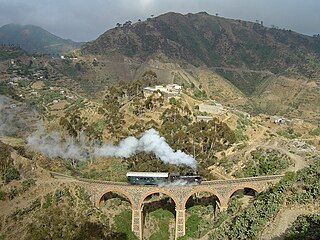
The Eritrean Railway is the only railway system in Eritrea. It was constructed between 1887 and 1932 during the Italian Eritrea colony and connects the port of Massawa with Asmara. Originally it also connected to Bishia. The line was partly damaged by warfare in subsequent decades, but was rebuilt in the 1990s. Vintage equipment is still used on the line.

Massawa or Mitsiwa is a port city in the Northern Red Sea region of Eritrea, located on the Red Sea at the northern end of the Gulf of Zula beside the Dahlak Archipelago. It has been a historically important port for many centuries. Massawa has been ruled or occupied by a succession of polities during its history, including the Kingdom of Aksum, the Ethiopian Empire, the Ottoman Empire and the Kingdom of Italy.
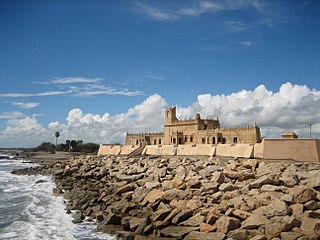
Colonial architecture is a hybrid architectural style that arose as colonists combined architectural styles from their country of origin with design characteristics of the settled country. Colonists frequently built houses and buildings in a style that was familiar to them but with local characteristics more suited to their new climate. Below are links to specific articles about colonial architecture, specifically the modern colonies:
Dekemhare is a town in Eritrea, lying south east of Asmara. Developed as an industrial center, it became a large scale industrial and transportation city, known for its vineyards but was partly destroyed in the Eritrean War of Independence.some of the villages around Dekemhare city are, Hadamu (ሃዳሙ), Amhur (ኣምሁር), Awlietseru(ኣውሊዕ ጸሩ) Gurae(ጉራዕ), Tukul (ቱኹል), Qeyhkor, (ቀይሕኮር), Afelba, (ኣፈልባ), Metsalu(መጻሉ)

The Fiat Tagliero Building is a Futurist-style service station in Asmara, Eritrea. It was completed in 1938 and designed by the Italian engineer Giuseppe Pettazzi.

The Cinema Impero is an Art Deco-style cinema in Asmara, the capital of Eritrea. It was built in 1937 by the colonial authorities in Italian Eritrea.

The Governor's Palace is the city hall of Asmara, Eritrea. It was built during the colonial period in the city centre, in an Italian Art Deco style.
The World Bank Building of Asmara, Eritrea is a large Italian villa built in 1938 which was bought by the World Bank to house its headquarters in that country. The architecture of the building is a mixture of futurist and art deco architectural styles.
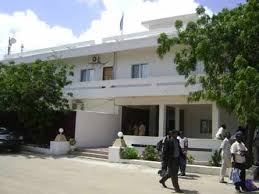
Villa Somalia in Mogadishu, is the palace and principal workplace of the president of Somalia. The current occupant of Villa Somalia is President Hassan Sheikh Mohamud (HSM).

Eritrea, officially the State of Eritrea, is a country in the Horn of Africa region of Eastern Africa, with its capital and largest city at Asmara. It is bordered by Ethiopia in the south, Sudan in the west, and Djibouti in the southeast. The northeastern and eastern parts of Eritrea have an extensive coastline along the Red Sea. The nation has a total area of approximately 117,600 km2 (45,406 sq mi), and includes the Dahlak Archipelago and several of the Hanish Islands.

Italian Eritreans are Eritrean-born citizens who are fully or partially of Italian descent, whose ancestors were Italians who emigrated to Eritrea during the Italian diaspora, or Italian-born people in Eritrea.

Italian Eritrea was a colony of the Kingdom of Italy in the territory of present-day Eritrea. The first Italian establishment in the area was the purchase of Assab by the Rubattino Shipping Company in 1869, which came under government control in 1882. Occupation of Massawa in 1885 and the subsequent expansion of territory would gradually engulf the region and in 1889 borders with the Ethiopian Empire were defined in the Treaty of Wuchale. In 1890 the Colony of Eritrea was officially founded.
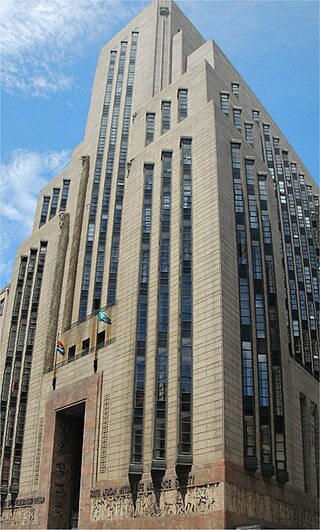
The Mutual Building, in Cape Town, South Africa, was built as the headquarters of the South African Mutual Life Assurance Society, now the "Old Mutual" insurance and financial services company. It was opened in 1940, but before the end of the 1950s—less than 20 years later—business operations were already moving to another new office at Mutual Park in Pinelands ; since then Old Mutual has become an international business and their present head office is in Johannesburg.

Astor Mansions is an Art Deco style building that was designed by architects Obel & Obel in 1931 and completed in 1932. The building was residential with street level retail and first floor professional office space. It was built to the maximum height of 140 feet permitted by the City Council. The building had a short lived stint as the tallest building in Johannesburg until the completion of the Ansteys Building in 1935.
The following is a timeline of the history of the city of Asmara, Eritrea. Asmara was under Italian colonial rule from 1889 until 1941.
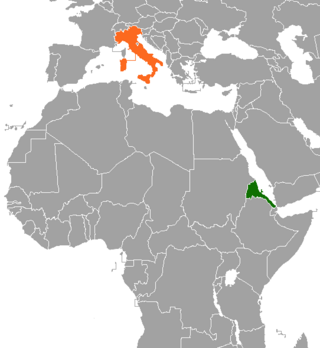
Eritrea–Italy relations are the bilateral relations between Italy and Eritrea. Both nations are members of the United Nations.

Bar Zilli is a building located in central Asmara, Eritrea. Currently, it operates as a restaurant and it serves as a commonly identifiable landmark to Asmara residents.
















